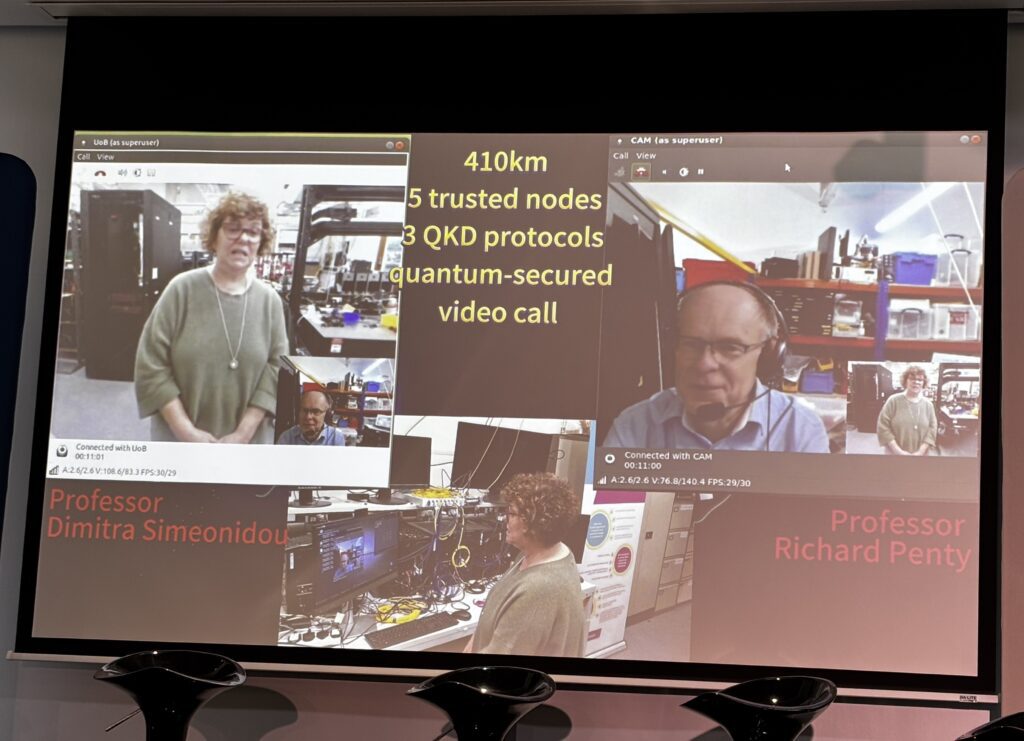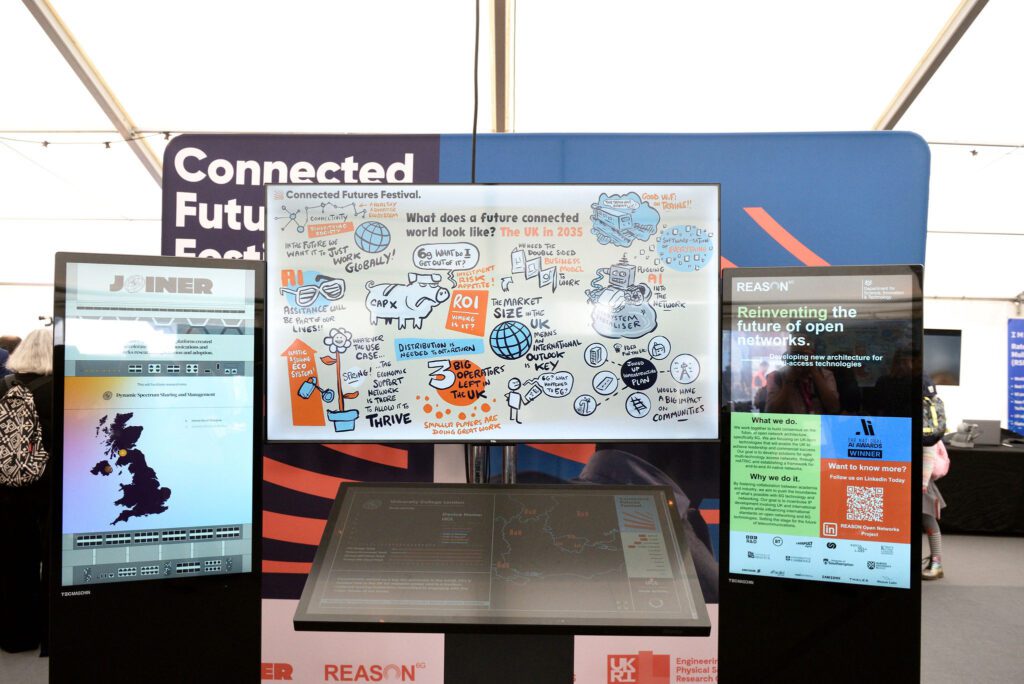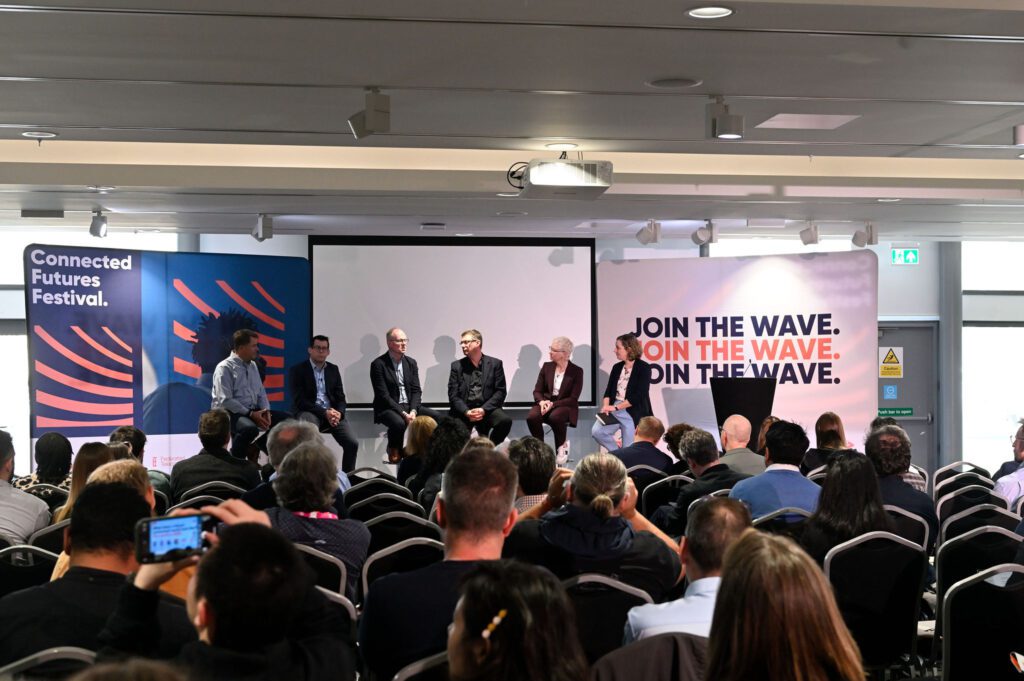Artificial Intelligence
Net zero
Quantum
Wise words and waggishness… December 2025
Reading time: 5 mins
What the UK’s Connected Futures Festival tells us about 6G strategy and the hurdles it needs to jump
It began with a world first: a quantum-secured video call between Professor Dimitra Simeonidou, director of the University of Bristol’s Smart Internet Lab, and Professor Richard Penty, head of the School of Technology at the University of Cambridge. The call, encrypted using quantum key distribution (QKD), travelled more than 410 kilometres across a new nationwide network of dark fibre. The network integrated three QKD protocols and passed through five trusted nodes – a milestone in secure communication and a sign of what’s to come.
This demonstration set the tone for the Connected Futures Festival, a one-day showcase of UK-led innovation in connectivity, technology, and cross-sector collaboration. From immersive art and smart infrastructure to quantum resilience and next-gen networks, the event invited researchers, policymakers, technologists, and creatives to ask not just what we can build but also why, for whom, and how we get it right?
As Chris Bryant, Minister of State at the Department for Science, Innovation and Technology said in his opening remarks, “If we are to make the UK a genuine science and tech superpower, this kind of collaborative innovation is exactly what we need. We must make sure connectivity isn’t something we take for granted. It’s fundamental to productivity, growth and global competitiveness.”

Bryant also spoke to the strategic role of public investment in connectivity.
“From quantum-secure comms to 6G testbeds, we need to back the science while building the skills and partnerships to make it count on the ground.”
That on-the-ground focus – spanning healthcare, transport, manufacturing, cities, and the creative economy – drove home one of the festival’s clearest messages: future networks aren’t just about speed. They’re about making better decisions, building fairer systems, and working across disciplines to solve real-world challenges.
In her keynote, Nektaria Efthymiou, network platform and security research director at BT Group, outlined a vision for connectivity that is as ambitious as it is urgent.
“Digital connectivity is more important than ever,” she said. “But now is the time to focus on purposeful innovation and drive new services and business models.”
Efthymiou highlighted the dual role of AI in shaping future networks. “AI, and in particular, generative AI, is democratising the use of technologies,” she said. “This transformation will potentially impact the use of networks in two ways: AI for networks, and networks for AI.”
She described a shift from manual oversight to autonomous orchestration, where automation with AI will evolve our relationship with network operations, shifting from manual tasks to human-app supervision to full autonomy. As a consequence, new architectures and programmable interfaces will enable a more agile future.
“APIs and automation will allow better and optimised use of those networks from the applications, creating new ways to monetise network capabilities,” said Efthymiou.
But with opportunity comes responsibility.
“Energy efficiency and reducing carbon emissions are becoming increasingly important,” she said, adding that future networks must operate more like “a biological immune system, unified, adaptive, and secure.”
Quantum was another recurring theme, both as a threat and as a tool.
“Quantum computing poses a threat to existing encryption mechanisms, which the telecom sector is taking very seriously,” she said. “But there’s also an opportunity to leverage quantum computing to significantly improve network planning and optimisation…to connect distributed quantum computers, and quantum sensors.”
Her closing message underscored the festival’s broader ambition.
“The future network is not just about connectivity, it’s about creating an ecosystem where innovation can thrive. By embracing collaboration, we can overcome the challenges facing the telecom sector and unlock new opportunities for growth.”

What will connectivity look like in 2035? If the expert panels at Connected Futures had one message, it was that the future in connectivity is coming surprisingly fast – but without clarity, collaboration, and commercial alignment, we risk missing an opportunity.
Simon Fletcher, CEO of Real Wireless, reflected on the long view. “By 2035, I’d like to see a device experience that’s the same wherever you are in the world,” he said. “But that means embracing open networks and creating space for interoperability. That’s fundamental to how we need to proceed.”
Magnus Frodigh, VP of Ericsson Research, pointed to human-machine interaction as the frontier. “AI assistants in phones are just the start. We’ll be using glasses, ambient interfaces… even robots. We need productivity but also competitiveness.”
But optimism was tempered by economic reality. Dan Warren, director of communications research at Samsung Research UK, was blunt. “5G hasn’t delivered the return operators expected,” he said. “The money isn’t sitting there waiting for 6G. If we want to build new networks, they’ll need to create new revenue and that’s going to have to come from B2B.”
Bo Olofsson of Nokia Bell Labs agreed that value creation, not just innovation, must lead. “We can throw all the technology at them, but if businesses can’t adopt it and make money from it, it won’t scale.”
And Doug Pulley, CTO of RANsemi, called for a reset in how standards are approached. “We need to make standards decisive again not just a list of ingredients. Simplification is what we should learn from previous generations.”
The future may be smart, but the barriers are very human. As Ian Smith, head of UKTIN, put it:
“The real challenge isn’t just infrastructure. It’s mindset, culture, and business models. We haven’t fully learned the adoption lessons.”
On inclusion and scale, Ros Singleton, consultant at Hindsight Associates, warned of market limitations. “The UK isn’t big enough to support developments that can’t scale globally,” she said. “We have to think about longer service cycles and alignment with international needs.”
Taken together, the panels painted a picture of a 2035 that is achievable – but only if today’s innovation is paired with deep systems thinking, cross-sector collaboration, and long-term ambition.

Across sectors – from culture to care, manufacturing to mobility – speakers made a compelling case for how advanced digital connectivity can educate, enable and empower. But they were equally clear that transformation is not guaranteed. It depends on readiness, intentionality, and real-world design.
In the creative industries, Claire Reddington, CEO of Watershed, described how connectivity can unleash imagination and community. “Togetherness is what makes us human,” she said. “It’s what makes a hopeful future possible. We’re excited by the possibilities for near-instantaneous holographic content… multi-sensory environments, and mixed reality collaboration.”
But she also raised a warning. “We must look very closely at the structures of power inherent in and around the technologies we’re using… If we’re to develop sustainable and equitable technologies, we must also centre climate justice in our work.”
In health and social care, Jessica Pyett-Ellis of WM5G imagined a system transformed by AI, sensors and real-time data, from proactive care and remote diagnostics to training, rehab and home independence.
“6G could bridge gaps that have felt immovable for decades… We could build equity through connectivity but only if we plan for it.”
She added that the real barrier to adoption isn’t innovation, it’s operational complexity.
“Change is really hard, especially when the system is already working flat out,” she said.
Michaela Nelson, head of future telecoms at the Department for Transport, showed how complex the challenge becomes at scale.
“We’re using all the Gs, all the orbits, all the spectrum,” she said. “Digital communications on the transport network are highly complex. I don’t think we need everything, everywhere, all of the time – I think we need the right connectivity, where and when it’s needed.”
In manufacturing, Marc Funnell of the National Composites Centre (NCC) laid out the promise of smart design, digital twins, and circular products, all underpinned by reliable data and secure connectivity. But it’s about improving on what we already have. There’s no point chasing a new technology if there is not a leap forward in capability.
“We don’t want to just design for manufacturing or for sustainability. We need to start designing from the data, from how these products perform in the real world,” said Funnell. But he cautioned against chasing novelty for its own sake.
“There’s no point adopting a new technology unless there’s a real leap forward in capability. We can’t wait anymore. Net zero is coming and we need to get products that are way more complex, and probably don’t even exist today, out into the market as soon as possible… the blocker isn’t capex, it’s the IT team asking, ‘What’s wrong with what I’ve got today?’”
And in cities, Paul Wilson, chair of SmartCitiesWorld, argued that if we want to change systems at scale, we need to act like systems.
“Cities cover just 3% of the Earth’s surface but generate 80% of GDP and most of the world’s carbon. That’s where we win or lose. We don’t need more pilots, we need more JOINERs… Leadership on data sharing, collaboration, and energy obsession must become the norm.”
Across these use cases, the message was consistent: the technology is coming. The value is real. But the readiness – technical, operational, and cultural – is not to be assumed and needs some work.
If the Connected Futures Festival revealed one thing, it’s that we already know what the future could look like. The real work is making it real, in collaboration, with industry and government, as well as academia.
Across quantum-secured communications, AI-driven services, and sector-spanning pilots, the day offered a glimpse of what’s possible. But it also laid bare the scale of the challenge, from legacy systems and fragmented infrastructure, to the need for trust, inclusion, and culture change.
Certainly, resiliency and net zero were mentioned often, especially in light of the recent Heathrow meltdown. On that score, Pulley at RANsemi warned against concentrating too much capability in a single place.
“The trend toward mega data centres introduces risk,” he said. “We’re concentrating too much in one place. We need distributed functionality, not just for physics and latency, but for resilience.”
That pragmatic urgency was echoed throughout the day, in healthcare pilots that risk being too complex to scale, in factories returning to Wi-Fi despite 5G trials, in cities asking for “everything, everywhere, all at once,” but needing the right governance to match.
The UK has shown it can lead on research, on creativity, and on pilot-stage collaboration. But turning that leadership into global competitiveness will require more than technology. It demands joined-up infrastructure, sustained investment, brave policy, and deep cross-sector coordination.As Jessica Pyett-Ellis put it: “If we design for the PowerPoint slides and not for the real world, it will fail.”

Working as a technology journalist and writer since 1989, Marc has written for a wide range of titles on technology, business, education, politics and sustainability, with work appearing in The Guardian, The Register, New Statesman, Computer Weekly and many more.
Quantum
Reading time: 10 mins
Quantum
Reading time: 10 mins
Quantum
Reading time: 11 mins
Robotics
Reading time: 1 mins
Quantum
Reading time: 3 mins